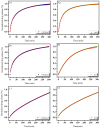From Design to Study of Liposome-Driven Drug Release Part 1: Impact of Temperature and pH on Environment
- PMID: 37511447
- PMCID: PMC10380247
- DOI: 10.3390/ijms241411686
From Design to Study of Liposome-Driven Drug Release Part 1: Impact of Temperature and pH on Environment
Abstract
The marketed drug Doxorubicin (DOX) and the promising anti-cancer agent 9-(N-piperazinyl)-5-methyl-12(H)-quino[3,4-b][1,4]benzothiazinium chloride (9-PBThACl) were used to prepare and compare a range of liposomal delivery systems based on dipalmitoylphosphatidylcholine (DPPC). Liposome-assisted drug release was examined using the spectrophotometric method. In order to provide in vitro release characteristics of liposomal conjugates (LDPPC/drug vs. LDPPC/drug/drug) as well as to evaluate the impact of temperature and pH buffering on the conformation/polarity of the phospholipid bilayer, the encapsulation efficiency of the liposomes entrapping 9-PBThACl and DOX was calculated. In fact, some competition between the investigated molecules was noticed during the entrapment process because relatively high values of the encapsulation efficiency were observed only for the liposomal complexes containing one trapped drug molecule. An averaged absorbance value enabled us to indicate the pH value of the environment (pH ≈ 6.8), at which the physicochemical property profiles of the liposomal complexes were noticeably changed. Moreover, the operational factors limiting the drug release kinetics from the produced liposomes were mathematically modeled. First-order and Bhaskas models ensured satisfactory compliance with the experimental data for the liposomal complexes buffered at pH values of 5.50, 6.00, and 7.40, respectively.
Keywords: drug release profile; encapsulation efficiency; liposomal delivery systems; nanocarriers.
Conflict of interest statement
The authors declare no conflict of interest.
Figures












References
-
- Pentak D., Sułkowski W.W., Sułkowska A. Influence of some physical properties of 5-fluorouracil on encapsulation efficiency in liposomes. J. Therm. Anal. Calorim. 2012;108:67–71. doi: 10.1007/s10973-011-1822-0. - DOI
-
- Langer R. Drug delivery and targeting. Nature. 1998;392:5–10. - PubMed
-
- Pentak D. Evaluation of the physicochemical properties of liposomes as potential carriers of anticancer drugs: Spectroscopic study. J. Nanopart. Res. 2016;18:126. doi: 10.1007/s11051-016-3427-9. - DOI
MeSH terms
Substances
LinkOut - more resources
Full Text Sources

